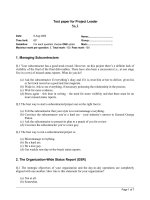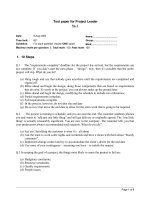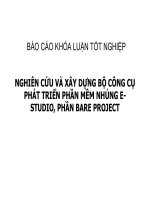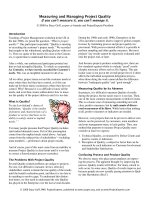SIM335 Managing Project
Bạn đang xem bản rút gọn của tài liệu. Xem và tải ngay bản đầy đủ của tài liệu tại đây (820.26 KB, 38 trang )
SIM335 - Managing Project
Nguyen Thi Kieu Anh - ID. 149078874/1
ASSIGNMENT COVER SHEET
UNIVERSITY OF SUNDERLAND
BA (HONS) BANKING AND FINANCE
Student ID: 149078874/1
Student Name: Nguyen Thi Kieu Anh
Module Code: SIM 335
Module Name / Title: Managing Project
Centre / College: Banking Academy of Viet Nam
Due Date: 15th May 2015
Hand in Date: 15th May 2015
Assignment Title: Individual assignment
Students Signature: (you must sign this declaring that it is all your own work and all sources of
information have been referenced)
Nguyen Thi Kieu Anh
1
SIM335 - Managing Project
Nguyen Thi Kieu Anh - ID. 149078874/1
Managing Project
SIM 335
Nguyen Thi Kieu Anh - ID:149078874/1
Submission date: 15th May 2015
Number of words: 3,468
2
SIM335 - Managing Project
Nguyen Thi Kieu Anh - ID. 149078874/1
TABLE OF CONTENTS
INTRODUCTION ..................................................................................................................... 4
TASK 1 ...................................................................................................................................... 5
1. Core principles/ characteristics of any project and its important ....................................... 5
2. Defining the scope of the project ....................................................................................... 5
3. Identify the critical path and plotting out a full project Gantt chart ................................... 6
4. Cost management method(s) .............................................................................................. 7
5. Risk assessment and management...................................................................................... 8
6. Quality method(s) used for successful completion of the project ...................................... 9
REFERENCES ........................................................................................................................ 10
TASK 2 .................................................................................................................................... 11
EXECUTIVE SUMMARY ..................................................................................................... 12
INTRODUCTION ................................................................................................................... 13
DETAIL PROJECT PLAN ...................................................................................................... 14
I. Overview of the project plan............................................................................................ 14
II. Project Life Cycle (PLC) ................................................................................................. 14
1. Project initiation ........................................................................................................... 14
2. Project planning ............................................................................................................ 17
3. Project implementation ................................................................................................. 24
4. Project closure .............................................................................................................. 26
CONCLUSION ........................................................................................................................ 27
REFERENCES ........................................................................................................................ 28
APPENDICES ......................................................................................................................... 29
3
SIM335 - Managing Project
Nguyen Thi Kieu Anh - ID. 149078874/1
INTRODUCTION
The primary purpose of this assignment is to summarize and analyse all aspects relevant to a
project. In the first task, all information of a project from core characteristics, scope, and
critical path, grant chart, cost management, risk management to even quality method used for
successful completion of a project is thoroughly mentioned. In the second task, the writer
plays an important role as project manager of Parker Ltd who has responsibility for outlining
the necessary activities to open new leisure facility, and ensuring that it can open on-time,
and within budget. Hopefully, this assignment may assist in understanding the important role
of a project, especially knowing exactly how to set up and implement a project in practice.
4
SIM335 - Managing Project
Nguyen Thi Kieu Anh - ID. 149078874/1
TASK 1: Different aspects of a project
1. Core principles/ characteristics of any project and its important
According to the Project Management Institute - PMI (2008, p.5), a project is defined as a
temporary endeavor undertaken to create a unique product, service, or result. It can be said
that core characteristics of a project are reflected in its definition, namely temporary and
unique. Temporary means that every project has a definite beginning and definite end. The
end is reached when the project’s objectives have been achieved, or when the project is
terminated because its objectives will not or cannot be met, or when the need for the project
no longer exists. Unique means that the project involves doing something which has not been
done before. A project is always unique on schedule (its beginning and end), resources
allocation (budget, human…), specifications (quality), and given targets (objectives) (PMI,
2008, p.5). Each characteristic plays an important role in the success of the project. In
particular, the identification of a clear objective and specifications, the creation of a realistic,
detailed and accurate schedule and budget as well as the utilization of others resources
properly will help the project to run effectively, thereby achieving the ultimate goal with
excellent outcome. As Linda (2015) stated, starting a project without clear objectives,
specific direction and a prepared plan of action is like starting out on a road trip with no idea
where you are going or how to get there. You will waste gas, time and effort.
2. Defining the scope of the project
In order to define the scope of any project, its three key components that are boundaries
(identify what is included and what is not included in the project), deliverables (the outputs
that project is expected to gain or produce), and requirements (the interests and expectations
of project stakeholders) need to be determined (McConnell, 2010) and Parker Ltd has no
exception. For example, in terms of boundaries, Parker Ltd has responsibility for ensuring the
initial opening of a new leisure facility and operational requirements of the new leisure
5
SIM335 - Managing Project
Nguyen Thi Kieu Anh - ID. 149078874/1
facility. The provision includes swimming pool, sports hall, dry and wet changing facilities,
two dance studios. All other leisure facilities are out of the scope. The project may have
deliverables such as all necessary equipments for new leisure facility are installed properly
and meet high quality standard. Requirements may include: the project must be completed on
time and within budget.
3. Identify the critical path and plotting out a full project Gantt chart
From the given data, a network diagram is formed to provide a graphic view of the project for
easier identification of the critical path.
3.1 Network diagram
Figure 1: The network diagram (Activity-on-note)
6
SIM335 - Managing Project
Nguyen Thi Kieu Anh - ID. 149078874/1
3.2 Critical Path
Paths
Duration
1
A-C-F-H
5 + 6 + 8 + 3 = 22
2
B-D
4+2=6
3
B-E-G
4 + 5 + 4 = 13
Table 1: The duration of the paths through the CPM diagram
The critical path is the longest-duration path through the network (Larson and Gray, 2011,
p.643). Therefore, critical path in this case is A - C - F - H which takes 22 days to complete
the project and it is highlighted in the red color in the network diagram above. The time to
complete the project is 22 days.
3.3 Gantt Chart
Gantt charts are bar charts that display a schedule of all the activities (Burke, 2003, p.166).
By using the following Gantt chart, it is easy to see the relationships between activities and
time.
Figure 2: Gantt chart
Assuming that this project starts on 14 April 2015, it will finish on 13 May 2015 as Saturday
and Sunday are non-working days. The critical path is highlighted in red color.
4. Cost management method(s)
The methods used for cost management are Earned Value Analysis (EVA) and the Milestone
Analysis. Each method offers functionalities targeting certain applications. Earned Value
7
SIM335 - Managing Project
Nguyen Thi Kieu Anh - ID. 149078874/1
Analysis measures a project’s schedule and cost performance by comparing actual and
planned schedule and costs to find out whether they are ahead or behind the plan. It helps
forecast future performance, project completion dates and especially enables manager
identify and control problems before they become insurmountable (Milosevic, 2003, p.422).
Similarly, Milestone Analysis also used to forecast final project cost, completion date, and
develop correction actions if necessary. However, drawbacks of Milestone Analysis are less
effective and less detailed than EAV. Conversely, because of such thing, it creates advantages
for Milestone Analysis is that it needs less management effort to set up and maintain (Dennis,
2007, p.446). Therefore, it can be said that two methods are useful in different case. Project
manager will choose the appropriate method to apply, depending on certain projects. For
example, as for small project, project manager should use Milestone Analysis.
5. Risk assessment and management
According to Pinto (2013, p. 236), risk management is the process of identifying, analyzing,
and responding to risk factors throughout the life of a project. In the project of Parker Ltd, the
project manager can apply risk management model of Burke (2003) to identify and manage
the risk. This model includes five steps, namely define objectives (what have to achieve),
identify risk (identify areas of risk, uncertainty and constraints which may impact on the
project), quantify risk (evaluate the risks and prioritize the level of risk), develop response
(how to respond to the identified risks) and risk control (continuing monitor and review the
level of risk) (Burke, 2003, p.253). All the risks are recorded in a document - called Risk
Register or Risk Log. It includes identified risks, probability score, impact score, priority and
planned response strategy. All information in this document need to update regularly to
ensure that the people understand the process and status of the risk.
8
SIM335 - Managing Project
Nguyen Thi Kieu Anh - ID. 149078874/1
6. Quality method(s) used for successful completion of the project
Managing the quality of the project is very important for completing the project successfully.
In order to have better quality management, Parker’s project manager can approach PDCA
cycle (Deming cycle) which is an iterative four-step management method (Plan - Do - Check
- Act) used for the control and continuous improvement of processes and products (Roughton
and Crutchfield, 2014, p.353). Specifically PDCA helps plan and implement the work in a
basic way, limit the errors during project execution. This also increases team member
autonomy when they know how to set up the small plans before embarking on the work,
knowing how to check and fix minor errors without the help of the project manager. Besides,
method of milestones evaluations should be applied in the form of review process before and
after every important task as purchasing, installing, testing equipments to support PDCA
cycle. Especially, final project audit is implemented at the end of the project to ensure that
everything was completed as agreed by the customers - local authority (University of
Sunderland, 2014, p.122).
9
SIM335 - Managing Project
Nguyen Thi Kieu Anh - ID. 149078874/1
REFERENCES
Burke, R. (2003) Project Management, Planning and Control Techniques. San Francisco,
US: John Wiley & Sons Inc.
Dennis, L. (2007) Project Management. England: Gower Publishing Limited.
Larson, E. W. and Gray, C. F. (2011) Project management: The managerial process. New
York: The McGraw-Hill Inc.
Linda, R. (2015) The Importance of Clear Objectives, Directions & Project Plans. Available
at: (Accessed: 14 April 2015).
McConnell, E. (2010) Boundaries, Deliverables And Requirements As Key Components Of
Project Scope. Available at: />(Accessed: 14 April 2014).
Milosevic, D.Z. (2003) Project Management ToolBox: Tools and Techniques for the
Practicing Project Management. Canada: John Wiley & Sons Inc.
Pinto, J.K. (2013) Project Management: Achieving Competitive Advantage. England: Pearson
Education Limited.
Project Management Institute (2008) A guide to the Project Management Body of Knowledge
(PMBOK guide). Pennsylvania: Project Management Institute.
Roughton, J. and Crutchfield, N. (2014) Safety Culture: An Innovative Leadership Approach.
United States: Elsevier Inc.
University of Sunderland (2014) Managing Project. United Kingdom: University of
Sunderland.
10
SIM335 - Managing Project
Nguyen Thi Kieu Anh - ID. 149078874/1
TASK 2
Parker Ltd New Leisure Facility Project
Prepared for: Parker Ltd
Prepared by: Project Manager - NGUYEN THI KIEU ANH
11
SIM335 - Managing Project
Nguyen Thi Kieu Anh - ID. 149078874/1
EXECUTIVE SUMMARY
This report concerns project of Parker Ltd in opening a new leisure facility to local authority.
The project plan is proposed by project manager to ensure this new leisure facility can open
on-time and within budget. Project manager approaches this project from a project life cycle
perspective, called four phases of Project Life-Cycle, namely: Concept and Initiation phase,
Design and Development phase, Implementation phase or Construction phase and
Commission and handover phase. In order to monitor and control the project progress, the
project manager uses a lot of tools and techniques include Work Breakdown Structure,
Network Diagram to estimate time duration of project; and Bottom-up method to accurately
estimate costs. Furthermore, risk management matrix and project control method also used to
ensure that the project will be completed successfully. The estimated project will be carried
out within 3 months from 1st May 2015 to 30th July 2015 with the budget of £67,463.
12
SIM335 - Managing Project
Nguyen Thi Kieu Anh - ID. 149078874/1
INTRODUCTION
Parker Ltd is a consultancy company started in 2002 and specializes in the sport and physical
activity sector. Currently, the company undertakes a one off special project proposed by local
authority proposes for Parker Ltd. This project is concerned with the ensuring the initial
opening and operational requirements of the new leisure facility are identified. The provision
includes: swimming pool, sports hall, dry and wet changing facilities, two dance studies with
additional health and fitness provision in form of a state of the art fitness centre. As a project
manager of Parker Ltd, the writer have the responsibility for outlining the activities required
to successfully implement this new initiative, and ensuring that it can open on-time, and
within budget.
13
SIM335 - Managing Project
Nguyen Thi Kieu Anh - ID. 149078874/1
DETAIL PROJECT PLAN
I. Overview of the project plan
The project of Parker Ltd mainly focuses on the purpose of opening a new leisure facility
with provision of the necessary equipments. This project needs a specific plan for
controlling and handling day-to-day operations to make sure that the project is
implemented and completed on time and within budget. The project plan will be described
in stages of project life cycle. Besides, a variety of project management tools and
techniques such as Gantt chart, Network Diagram, Work Breakdown Structure, Risk
Assessment, and Project Control is also applied by project manager to support for
achieving the given objectives of Parker Ltd’s project.
II. Project Life Cycle (PLC)
Project Life Cycle helps to divide the work into more manageable phases for easier
management and better control of the work. As Field and Keller (1998, p.61) stated, there
is no single life-cycle that applies to all project. Hence, there are many different versions
of project life cycle such as five-phase model (Weiss and Wysocki, 1992), development
life cycle (a sequence of mini projects) (Jordan and Machesky, 1990), prototyping life
cycle (Park, Chae and Kang, 1991) and so on. However, in the scope of Parker project, it
should be applied Burke’s project life cycle model (2003) to achieve best result. That
proposal includes four phases, namely initiation (concept), development (design),
implementation and commission phase (refer to appendix 1)
1. Project initiation
In this phase, project objective, feasibility, deliverables, stakeholders, team building, and
manager’s competences need to be mentioned.
14
SIM335 - Managing Project
Nguyen Thi Kieu Anh - ID. 149078874/1
1.1. Project objectives
Project objective means what the project intend to do and want to achieve by the end of the
project (Field and Keller, 1998, p.226). A clear objective leads to a higher rate of project
success so project objectives should be SMART (specific, measurable, agreed, realistic
and time-limited) (University of Sunderland, 2014, p.21).
The project objective of Parker Ltd is to open a leisure facility within 3 months with
budget of £67,463.
This objective meets all the standards of “SMART”
‾
Specific: Ensuring the initial opening and operational requirements of the new
facility.
‾
Measurable: The project is implemented within 3 months and budget of £67,463.
‾
Agreed: Parker Ltd’s stakeholders all agreed with the project objectives.
‾
Realistic: Within 3 months and adequate resources, this project are achievable.
‾
Time-limited: The time for project is 3 months
1.2 Feasibility
Parker Ltd has run a business since 2002 and shown steady growth over the past thirteen
years. Therefore, with available resources (especially skills, knowledge and experience of
the staff), the implementation of this project is entirely feasible. Besides, in order to avoid
some unexpected risks, the company have already forecasted and given solutions for each
kind of risks.
1.3 Deliverables
Since this new leisure facility will already be built to a 21st Century standard so the
activities in project scope include: purchasing and installing fitness equipments,
recruitment, operational requirement testing and opening the ceremony. The activities such
as repair, rebuild, construction…are out of the scope of the project.
15
SIM335 - Managing Project
Nguyen Thi Kieu Anh - ID. 149078874/1
1.4 Stakeholders
Pinto (2013, p.58) states that project stakeholders are defines as all individuals or groups
who have an active stake in the project and can potentially impact, either positively or
negatively, its development. The stakeholders of this project are addressed and categorized
into 2 types:
‾
Internal stakeholder: Project manager and team members
‾
External stakeholder: Suppliers, customers (the local authority)
Stakeholder’s matrix (refer to appendix 2) point out the impact of stakeholders on the
project in terms of their power and interest, from that comprehend how to keep them
satisfied for stabilizing operations of the project.
1.5 Team building
Project team is a team whose members usually belong to different groups, functions and
are assigned to activities for the same project. Teams consist of between five and ten
people seem to work best (Roebuck, 2012, p.344). Parker Ltd’s project requires 8 core
team members, including: 1 General Manager, 1 Lead Consultant, 2 Administration staff,
1 Marketing Officer, 2 Technical specialists, 1 Human resouce officer. They is choosen
based on their qualifications, skills and experience.
Project Manager
Lead
Consultant
Administration
staff
Marketing
Officer
Technical
specialists
Human
resouce officer
Figure 1: Project Team
1.6 Manager’s competences
Manager’s responsibilities are to accomplish the project’s objective within a set
specification under time, cost and quality constraints and balance stakeholders’
16
SIM335 - Managing Project
Nguyen Thi Kieu Anh - ID. 149078874/1
expectations (William and Martin, 2004, p.2). In order to do this, manager need to meet
three types of competences, namely knowledge-based, performance-based and personal
competency. Project management knowledge competency includes knowing project
management techniques, processes and standards. For instance, project manager need to
have basic knowledge regarding how to set up and develop a project charter, a project
plan, how to direct, monitor and control project work, how to estimate costs and how to
allocate resources (time, budget, human...) properly to achieve project objectives.
Performance competency is evaluated based on manager’s qualifications and experience.
Manager who has better qualifications and experience on some projects will response
flexibly to unexpected change or risk arising during project implementation. Personal
competency means manager’s skills. The basic skills is required in this project, are
leadership skills, good communication skills, teamwork, negotiation and persuasion skills.
For example, project manager negotiate with suppliers to lower equipment price, persuade
customers to approve budgets or accept changes to project plans and scope, and
communicate and motivate the team members to increase their working efficiency (Diego,
2013).
2. Project planning
Project planning focuses on identifying roles and responsibilities of each team member in
the project, leadership style that manager uses to implement plan and motivate the people.
Furthermore, the project’s tasks and resource requirements are identified and visually
represented according to Work Breakdown Structure (WBS), Gantt chart, Network
diagram, along with the preparation of project budget.
2.1 Team development
After forming 8 core team members as mentioned above, project manager have to assign
tasks, help them understand their roles and responsibility in the project, especially develop
17
SIM335 - Managing Project
Nguyen Thi Kieu Anh - ID. 149078874/1
a strong team (refer to appendix 3). Project manager can apply Bruce Tuckman’s model
including five phases, namely forming, storming, norming, performing and mourning to
increase team performance (Turner, 2008, p.85).
2.2 Leadership
There are many different leadership styles that a manager of a company can choose to
approach such as autocratic (isolated decision), autocratic (informed decision),
consultative autocratic (discuss with individuals) consultative autocratic (discuss with
team), democratic, and laissez-faire. There is no style that leads to success in all
circumstances. Therefore, the key to being an excellent project manager is choosing the
right leadership style for each situation. For Parker Ltd’s project, in the first step of project
implementation, the manager can apply consultative autocratic style (discuss with
individuals). Project manager shares the problem with team members individually, to
collect the ideas and make his own decision (University of Sunderland, 2014, p.86).
Discussing individually to avoid the groupthink and help manager collect innovative ideas.
When the project runs smoothly, project manager can discuss with team member as a
group in order to develop teamwork and either make decision as his own (consultative
autocratic style discuss with team) or make decision as a group (democratic style).
2.3 Project assumption
Working schedule:
‾
5 days working a week (from Monday to Friday)
‾
8 hours per day
‾
Within no holiday
‾
Project start date: 1st May 2015
Human resources:
‾
Project team will work full time.
18
SIM335 - Managing Project
Nguyen Thi Kieu Anh - ID. 149078874/1
2.4 Work Breakdown Structure (WBS)
The work breakdown is a process by which the work of a project is divided and sub
divided for management and control purposes (University of Sunderland, 2014, p.27).
WBS of Parker Ltd’s project is presented as follows:
Figure 2: Horizontal Work Breakdown structure of project
2.5 Project Schedule
After having WBS, detail implementation plan for project is prepared as follows:
19
SIM335 - Managing Project
Nguyen Thi Kieu Anh - ID. 149078874/1
Activity
Name
Duration
Leisure facility project
65 days
Initiation
6 days
Predecessors
A
Setting project objective
2 days
-
B
Finding potential team members
4 days
A
Development
8 days
C
Appointing key team members
2 days
B
D
Kick off meeting
1 days
C
E
Planning
5 days
D
Implementation
Purchasing and installing fitness equipments
39 days
27 days
F
Listing all suppliers
2 days
E
G
Evaluating and selecting suppliers
4 days
F
H
Purchasing and transporting fitness equipments
6 days
G
I
Installing fitness equipments
15 days
H
Recruiting employees and coaches
15 days
J
Publishing the job descriptions
5 days
E
K
Filtering the Curriculum Vitae (CV)
2 days
J
L
Interviewing
3 days
K
M
Training
5 days
L
Testing operational requirements
10 days
N
Swimming pool
2 days
I
O
Sport hall
3 days
N
P
Dance studios
4 days
O
Q
Dry and wet changing facilities
1 day
P
R
Final approval of local authority
2 days
M, Q
Termination
Planning for opening ceremony
12 days
11 days
S
Cleaning and decoration
4 days
R
T
Listing and inviting the guests
2 day
R
U
Advertising
5 days
R
1 day
S, T, U
V
Opening ceremony
Table 1: Implementation plan of the project
20
SIM335 - Managing Project
Nguyen Thi Kieu Anh - ID. 149078874/1
The critical path of Parker’s project is presented in the network diagram (Activity-onNode) and Gantt chart (appendix 4). The critical path is A - B - C - D - E - F - G - H - I - N
- O - P - Q - R - U - V. It is highlighted in red color. Based on analysis, the project takes
65 days to execute and finish all the tasks. Because of 5-day working week and no holiday,
the project starts on Friday 1st May 2015; it would be finished on Thursday 30th July 2015.
According to this, the project will be possibly completed within 3 months as its objective.
2.6 Cost estimation
Budgeting is considered as one of the most important factors in a project as it decides
more than a half of the project’s success. Hence, Parker needs to estimate the cost of
project carefully and logically for the purposes of controlling the budget effectively. The
project manager uses Bottom-up costing method which based on the WBS to calculate
costs from the lowest level of activity up through the WBS (University of Sunderland,
2014, p.53). Cost estimation of Parker Ltd’s project is detailed in the following table:
Activity
Cost estimation
(£)
1
Planning
2
Finding and contracting with suppliers
3
Fitness equipment costs
4
Delivery cost
5
Fitness equipment installation
5,500
6
Recruitment and Training
2,650
8
Testing operational requirements
3,500
9
Cleaning and decoration
1,300
10
Advertising
2,100
11
Opening ceremony
1,000
Total cost
1,540
450
42,540
750
61,330
Contingency reserve (plus 10% of total cost)
Total of cost estimated
6,133
67,463
Table 2: Cost estimate for main stages of Parker’s project
21
SIM335 - Managing Project
Nguyen Thi Kieu Anh - ID. 149078874/1
22
The total cost is estimated at £61,330. According to Field and Keller (1998), the
contingency reserve is usually 10% of total cost, which is £6,133. Therefore the total cost
estimation is up to £67,463.
2.7 Risk assessment and management
Risk management is the process of identifying, analyzing, and responding to risk factors
throughout the life of a project (Pinto, 2013, p.236). Project manager applies risk
management model of Burke (2003) to identify and manage the risk of Parker Ltd’s
project.
Figure 3: Risk management model (Burke, 2003, p.253)
The objective of this project is to open a leisure facility within 3 months with budget of
£67,463. Identifying, qualifying and developing responses can be listed in the following
table
Risk
No.
Risk description
category
Probability
Impact
(P: 1-5)
(I: 1-5)
The cost of
1
equipments increases
Risk avoidance: Signing
2
4
sharply
Logistical
risk
2
Low quality of
equipments
Response risk
contract with suppliers to set
fixed prices
Risk reduction: Carefully check
5
5
the quality of equipment before
and after signing contracts
SIM335 - Managing Project
Nguyen Thi Kieu Anh - ID. 149078874/1
3
Equipment delivery
delay
23
Risk avoidance: Choose reliable
3
4
suppliers, payment of overdue
fines upon delivery
Risk avoidance: Purchase
insurance
Accident
risk
4
Occupational
accident
Mitigation: Use of personal
2
3
protective equipment and
clothing to minimize the risk,
training employees carefully
before using facility.
Technical
risk
Risk reduction: Monitor and
5
Installation errors
3
4
recheck the installation process
to ensure it right
Project team
6
Risk reduction: Select carefully,
members is
3
4
retrain or find alternative one
unprofessional
Risk reduction: Manager should
7
Human
Conflict between
team members
4
3
be open and active listen to
understand the problem and
give appropriate solutions
risk
8
Risk avoidance: Encourage and
Poor team
4
performance
4
excellent task completion
Team members quit
9
motivate by giving bonuses if
the job for personal
Risk avoidance: Signing labor
2
3
reasons
contract before running the
project
- Risk avoidance: Estimate
Financial
risk
10
Over budgeting or
budget recession
4
5
costs carefully and accurately
- Mitigation: Reduce cost of
unproductive activities
Table 3: Risk register of Parker’s project
Combined the probability and impact (severity) score, risk assessment matrix is given to
point out the risk levels of the project as follows:
SIM335 - Managing Project
Nguyen Thi Kieu Anh - ID. 149078874/1
Probability
Severity
1. Insignificant 2. Minor 3. Moderate 4. Major 5. Severer
5.Almost certain
2
4.Likely
7
8
3.Possible
10
3. 5, 6
2.Unlikely
4, 9
1
1.Rare
Low Risk
Medium Risk
High Risk
Table 4: Risk assessment matrix for Parker Ltd’s project
The risk of 2, 8 and 10 are classified as high risk, which is easy to happen and could
impact significantly on the project so project manager needs to pay more attention to avoid
them. Other risks have less impact and less chance to occur, but for best, project manager
should always put them under control.
3. Project implementation
3.1 Project control
According to Field and Keller (1998, p.271), control are the project manager’s
predominant activities during main execution phase. It is defined as the act of reducing the
difference between plan and reality. In the case of Parker Ltd’s project, there are two main
factors needed to be monitored and controlled are costs and time. To do this, project
manager can use Earned Value Analysis (EVA) method. As Nagrecha (2002, p.11) stated,
Earned Value Analysis is a better method of project management because it integrates
cost, schedule and scope. It measures a project’s schedule and cost performance to find out
whether they are ahead or behind the plan (schedule and cost variances) and forecast the
final project costs and project completion dates (Milosevic, 2003, p.422). It is considered
24
SIM335 - Managing Project
Nguyen Thi Kieu Anh - ID. 149078874/1
as an ‘early warning’ project management tool that enables managers to identify and
control problems before they become insurmountable. There are three quantities form the
basis for EVA, namely Budgeted Cost of Work Scheduled (BCWC) or Planned Value
(PV), Budgeted Cost of Work Performed (BCWP) or Earned Value (EV) and Actual Cost
of Work Performed (ACWP) or Actual Cost (AC) (Nagrecha, 2002, p.11). The formulas
regarding cost variance, schedule variance and other performance indices are listed in
appendix 5. To support for these calculations, it requires project team need collect and
keep all information about expenses in working process and report daily to manager.
Besides, project manager can control the completion time of each activity based on the
Gantt chart to identify exactly which activity is behind schedule for taking corrective
action.
3.2 Quality management
Project quality management is the processes required to ensure that the project will satisfy
the needs for which it was undertaken (PMI, 2008, p.189). In case of Parker facility
project, quality means successful opening a new leisure facility within 3 months and
budget of £67,463. All provisions of new leisure facility must meet the standard of the art
fitness centre. Parker’s project manager should adopt PDCA cycle which is developed by
Walter A. Shewhart and popularized by W. Edward Deming to manage quality better. It is
an iterative four-step management method (Plan - Do - Check - Act) used for the control
and continuous improvement of processes and products (Roughton and Crutchfield, 2014,
p.353) (refer appendix 6). Specifically PDCA helps plan and implement the work in a
basic way, limit the errors during project execution. This also increases team member
autonomy when they know how to set up the small plans before embarking on the work,
knowing how to check and fix minor errors without the help of the project manager.
Besides, method of milestones evaluations should be applied in the form of review process
25









